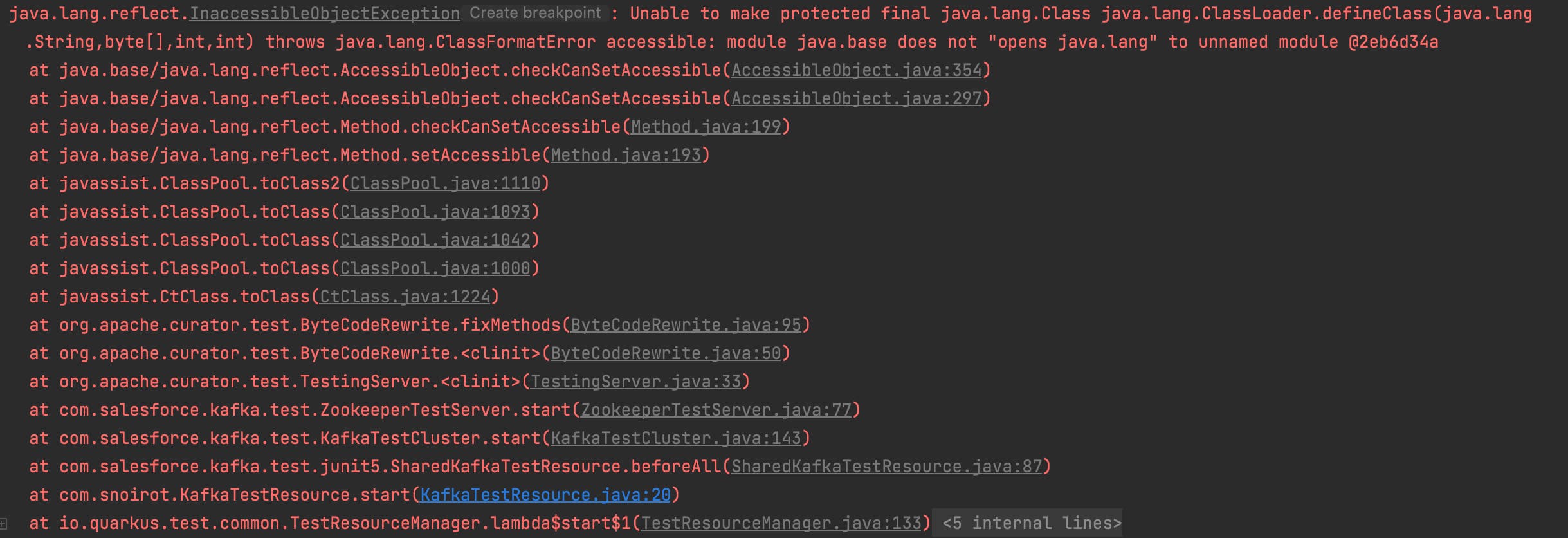When you start working with Quarkus, you discover the magic of dev services! If you have an application that use Kafka, a database, RabbitMQ, Redis, ... (full list here ), then if you don't have some properties set for dev and test profile like broker, url, ... Quarkus will start a dev service using Test Containers.
You get crazy, code as much as integration test as you can, it is so easy and finally push to your favourite CI/CD pipeline.
And now everything is red in your test job!!! Whyyyyy??? Well, your sys admin removed the dind from the runners... Yes using dind can create a security breach in your pipeline...
Of course they tell you that you can start a service (gitlab services for example) and plug your tests on it but you want it to work locally so having to start (maintain) a container, inject the correct urls, be sure to clean / setup the content properly,... no thanks.
We want to have something inside of the code.
We will see how to setup your Kafka cluster inside of your integration tests.
Create a Quarkus project
Let's go to code.quarkus.io, create a new project with those dependencies:
- SmallRye Reactive Messaging
- SmallRye Reactive Messaging - Kafka Connector
Now let's remove the classes generated (in main and test) and the META-INF
Create a new service KafkaService:
import io.smallrye.mutiny.Multi;
import java.time.Duration;
import javax.enterprise.context.ApplicationScoped;
import org.eclipse.microprofile.reactive.messaging.Incoming;
import org.eclipse.microprofile.reactive.messaging.Message;
import org.eclipse.microprofile.reactive.messaging.Outgoing;
import org.jboss.logging.Logger;
@ApplicationScoped
public class KafkaService {
public static final Logger LOGGER = Logger.getLogger(KafkaService.class);
@Outgoing("demo-kafka-out")
public Multi<Message<String>> produceData() {
return Multi.createFrom().ticks().every(Duration.ofSeconds(1))
.map(tick -> Message.of("SmallRye Hello " + tick));
}
@Incoming("demo-kafka-in")
public void consumeData(String message) {
LOGGER.infov("Message received {0}", message);
}
}
We have a simple example with one producer that will push every second a message and one consumer that will log this message.
We have to set the properties:
mp.messaging.outgoing.demo-kafka-out.connector=smallrye-kafka
mp.messaging.incoming.demo-kafka-in.connector=smallrye-kafka
mp.messaging.outgoing.demo-kafka-out.topic=demo-kafka
mp.messaging.incoming.demo-kafka-in.topic=demo-kafka
mp.messaging.outgoing.demo-kafka-out.value.serializer=org.apache.kafka.common.serialization.StringSerializer
mp.messaging.incoming.demo-kafka-in.value.deserializer=org.apache.kafka.common.serialization.StringDeserializer
Create a new empty test from KafkaService:
package com.snoirot;
import io.quarkus.test.junit.QuarkusTest;
import org.junit.jupiter.api.Test;
@QuarkusTest
class KafkaServiceTest {
@Test
void testKafkaService() {
}
}
So if we run this test, our test will be green and we can see some docker logs:

Test without dev service
First thing, we have to tell Quarkus to not use dev services but only for test profile:
%test.quarkus.kafka.devservices.enabled=false
If I run the test again, there is no docker logs anymore and we have a message saying that the connection to broker could not be etablished.

Setup QuarkusTestResourceLifecycleManager
Now we have to start a Kafka at the beginning of our test.
To do that, we will use QuarkusTestResourceLifecycleManager
We will create a KafkaTestResource that will implement QuarkusTestResourceLifecycleManager and start a Kafka broker there.
We need two dependencies that will contains the Kafka broker:
<dependency>
<groupId>com.salesforce.kafka.test</groupId>
<artifactId>kafka-junit5</artifactId>
<version>3.2.3</version>
<scope>test</scope>
</dependency>
<dependency>
<groupId>org.apache.kafka</groupId>
<artifactId>kafka_2.12</artifactId>
<version>2.8.0</version>
<scope>test</scope>
</dependency>
Now we can create KafkaTestResource:
public class KafkaTestResource implements QuarkusTestResourceLifecycleManager {
public static final Logger LOGGER = Logger.getLogger(KafkaTestResource.class);
private SharedKafkaTestResource sharedKafkaTestResource;
@Override
public Map<String, String> start() {
sharedKafkaTestResource = new SharedKafkaTestResource().withBrokers(3)
.withBrokerProperty("auto.create.topics.enable", "true");
try {
sharedKafkaTestResource.beforeAll(null);
} catch (Exception e) {
LOGGER.error("Error starting kafka broker", e);
}
return Map.of( "kafka.bootstrap.servers", sharedKafkaTestResource.getKafkaConnectString());
}
@Override
public void stop() {
if (sharedKafkaTestResource != null) {
sharedKafkaTestResource.afterAll(null);
}
}
}
This SharedKafkaTestResource would normally be used as an extension in Unit Tests with JUnit 5:
@RegisterExtension
static final SharedKafkaTestResource sharedKafkaTestResource = new SharedKafkaTestResource()
.withBrokers(1)
.withBrokerProperty("auto.create.topics.enable", "true");
and it will call the beforeAll to start the cluster and afterAll to stop it.
As I want to have an Integration Test, I have to call those methods myself.
This KafkaTestResource will return a map that will override the config map:
return Map.of( "kafka.bootstrap.servers", sharedKafkaTestResource.getKafkaConnectString());
It is really useful as the port of the broker is not fixed.
Now i just have to call this resource from my test:
@QuarkusTest
@QuarkusTestResource(value = KafkaTestResource.class, restrictToAnnotatedClass = true)
class KafkaServiceTest {
`
I recommend to use restrictToAnnotatedClass in case you have several Integration Tests.
Let's run the test. I see some exception about some module. I will just add this arguments to my test:

--add-opens java.base/java.lang=ALL-UNNAMED
Let's run the test again and see that the Kafka is started.

Create a test
To create a test, I will use Mockito and Awaitility:
<dependency>
<groupId>org.awaitility</groupId>
<artifactId>awaitility</artifactId>
<version>4.1.1</version>
<scope>test</scope>
</dependency>
<dependency>
<groupId>io.quarkus</groupId>
<artifactId>quarkus-junit5-mockito</artifactId>
<scope>test</scope>
</dependency>
NB : We can remove quarkus-junit5 dependency as it is included into quarkus-junit5-mockito
For my test, I will inject a Spy of my KafkaService and see if there is some call of consumeData which will mean my integration is working.
import static org.awaitility.Awaitility.await;
import io.quarkus.test.common.QuarkusTestResource;
import io.quarkus.test.junit.QuarkusTest;
import io.quarkus.test.junit.mockito.InjectSpy;
import java.time.Duration;
import org.junit.jupiter.api.Test;
import org.mockito.Mockito;
@QuarkusTest
@QuarkusTestResource(value = KafkaTestResource.class, restrictToAnnotatedClass = true)
class KafkaServiceTest {
@InjectSpy
KafkaService kafkaService;
@Test
void testKafkaService() {
var startTime = System.currentTimeMillis();
await().atMost(Duration.ofSeconds(10)).until(() -> System.currentTimeMillis() - startTime > 9000);
Mockito.verify(kafkaService, Mockito.atLeastOnce()).consumeData(Mockito.anyString());
}
}
I use the await to wait 9 seconds as it can take time before the consumer get registered from the cluster.
I run the test, everything is green!

Conclusion
We have seen that we can start a Kafka cluster inside our Integration Tests using kafka-junit5 and a bit of imagination.
I recommend you to go read their github so you can create more complex Integration Tests in the future!
